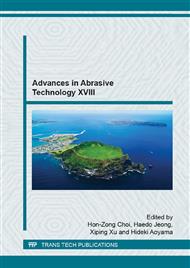p.321
p.327
p.333
p.338
p.343
p.350
p.359
p.365
p.371
Theoretical Research on Contact Length in the Rocking Motion Wire Saw
Abstract:
Rocking motion wire saw with the additional rocking motion of either the wire or the workpiece is a new machining method compared with the traditional wire saw. The length of contact between the wire and the workpiece changes in this new saw process. In this paper, the wire motion and the contact length were theoretically researched. Wire motion path equation with the rocking motion was established. The theoretical equation of the contact length in half a swing period was derived out. The results indicated that the wire motion was a single pendulum movement with a length line segment, which the swing pivot was moved with a feed rate. The contact length had significant changes in half a swing period in the rocking motion wire saw. The contact length varied periodically with the same amplitude in the square ingot sawing, which varied periodically with the variation amplitude in the circle ingot sawing. The contact length with the rocking motion was obviously shorter than the case without the rocking motion for either the square ingot or the circle ingot.
Info:
Periodical:
Pages:
343-349
Citation:
Online since:
January 2016
Authors:
Keywords:
Price:
Сopyright:
© 2016 Trans Tech Publications Ltd. All Rights Reserved
Share:
Citation:


